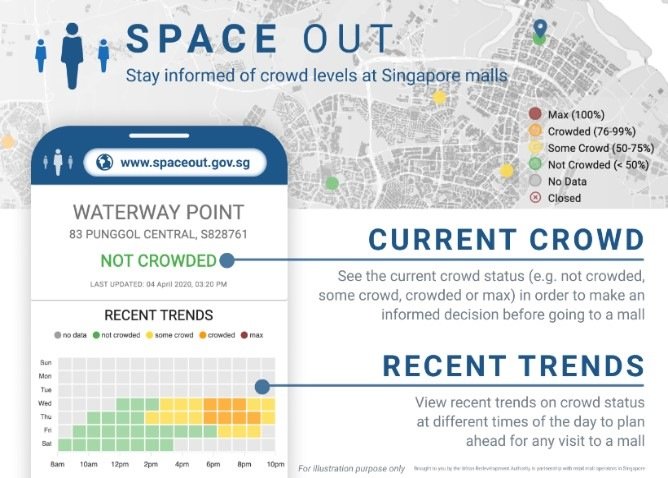Overview of Place Management in Singapore
In the last 10 years, placemaking efforts in Singapore have gained momentum and evolved from shaping thriving places to creating stronger communities.
Since the early efforts of businesses coming together in selected precincts such as Orchard Road and Chinatown in the 1990s, placemaking efforts in Singapore have extended to many more areas across the island.
It has gained further momentum especially in the last 10 years, expanding its role and scope in shaping thriving places and bringing communities together. It has been a confluence of both government and ground-up efforts that gave it greater impetus.
At precincts and neighbourhoods
At the national level, placemaking is recognised as a critical aspect in contributing to a liveable city and in ensuring the relevance and viability of precincts and destinations. Government agencies have been working in close partnership with stakeholders to drive such efforts in key precincts, demonstrating its value and possibilities and putting in place policies and frameworks where relevant.
One such area is Marina Bay. Proactive placemaking efforts since 2005 have strengthened its distinctive identity, enlivening the public promenade and drawing people in with a year-round calendar of activities. Signature events such as the Marina Bay Singapore Countdown, i Light Singapore and the Formula 1 Singapore Grand Prix have made it a favourite attraction and key destination for locals and tourists.
Between 2010 and 2014, active efforts and close engagements amongst public and private sector stakeholders took place behind the scenes in supporting the formation of placemaking associations in the Singapore River (set up in 2012) and Kampong Glam (set up in 2014) precincts.
From precincts to public spaces and streets
Beyond driving placemaking for key precincts and neighbourhoods, efforts also focused on the activation of public spaces and streets to promote interaction and vibrancy.
Initiatives such as the Lively Places Programme provides support in encouraging communities to turn open spaces into lively gathering places and transform streets into active public spaces.
Various ground-up groups have also initiated partnerships with communities to co-design, activate and manage community and public spaces for a variety of projects, from neighbourhood spaces to even car park lots.
Outcomes and impact
The various placemaking associations have carried out a variety of intiatives to help businesses and bring communities together.
Singapore River One (SRO)’s initial quick-win projects such as its anti-touting campaign and active programming successfully refreshed the river precinct’s appeal and instilled greater confidence amongst stakeholders to do more together. Its membership increased from an initial 12 members in 2012 to over 100 in early 2020.
Initiatives have created tangible benefits for businesses. Some of SRO’s past signature events such as the Singapore River Festival and Saint Patrick’s Day Street Festival have attracted more than 100,000 people. The weekend street closures at Circular Road have also led to increased footfall and higher sales as reported by stakeholders.

Singapore River Festival. Photo: Singapore River One
For historic districts such as Kampong Glam, active programming like its Ramadan bazaars, regular street closures and neighbourhood sketches bring out the vibrant culture and heritage of the area.
Beyond events and activities, Kampong Glam stakeholders have also created delightful moments such as initiating art murals on shophouses at different corners in the precinct. A long-time business owner who grew up in the area also took the initiative to transform a once vacant open space into a cosy community space for families and visitors with swings and benches.

Wall murals in Kampong Glam
Sustaining efforts in the long run
While efforts in key precincts had shown encouraging results over time, these had been carried out mainly on a voluntary basis. This is not sustainable in the long run as funding and resources are limited and will lead to a free-rider problem where stakeholders can choose not to contribute but stand to benefit from others’ contributions.
Thus from 2017, a more formal placemaking model is being tested through the pilot Business Improvement District (BID) programme, which serves to empower businesses and local communities to take on greater ownership in working together to tailor solutions and enhancements specific to their precincts. Through this programme, the government is providing matching funds for every dollar of membership fee raised, to encourage communities to pool resources together to support precinct-led initiatives.
So far, ten precincts have expressed interest to become pilot BIDs with the first (Singapore River One) formed in 2017 and four others successfully forming in 2019 and 2020.
Over the years, Singapore River One’s active placemaking efforts have strengthened the distinctive identity of the Singapore River and drawn more people in to enjoy the river. It has also seen stronger bonds developed amongst stakeholders. The strength of partnerships in other precincts have also brought out each of their unique charm and brought different communities together.
The placemaking journey in Singapore continues to unfold as communities, stakeholders and champions work together to create engaging, thriving and sustainable places for the future. Stronger relationships and networks in communities developed as a result will help us to overcome existing and new challenges.
How businesses and communities are coping with the COVID-19 pandemic
The COVID-19 pandemic has reinforced the role of placemaking in Singapore as the glue to build stronger connections in precincts and neighbourhoods.
At the heart of placemaking is its ability to manage places and spaces in a way that reflect the essence of people who inhabit these, promote our health and well-being, lift our spirits and connect us to each other.
Helping one another
The strength of a collective community spirit has been evident with businesses and communities coming together to help one another, tapping on strong networks and good relationships developed through placemaking over the years, reinforcing its importance particularly in the context of the COVID-19 pandemic in Singapore.
Placemaking associations in Tanjong Pagar, Orchard Road and the Singapore River in the city centre have proactively coordinated precinct-wide takeaway and delivery services and campaigns during the Circuit Breaker period (April to June 2020) when restaurants were closed to dine-in customers. This helped restaurants, cafes and bars in these areas continue to operate and remain viable. At Singapore River, its placemaking associations, the Singapore River One (SRO), has also rolled out vouchers to encourage spending at over 150 participating outlets (hotels, malls and restaurants) within the precinct.
Suuporting businesses further, SRO organised complimentary webinars on practical topics to help their stakeholders discuss the challenges on hand and secured discounted prices for businesses on essential items such as disinfectants during this period.
Outside the city centre, in the Jurong East area, the placemaking network served to render help readily to stakeholders who needed it. For example, stakeholders responded swiftly to Ng Teng Fong General Hospital’s call for donations of stationery, games, booklets and other resources for its COVID-19 patients.
Enjoying public spaces safely
In the current context, the availability and variety of public spaces in precincts and neighbourhoods have become even more important as people find ways of seeking relief and inspiration, enhancing their well-being and connecting with each other in a safe manner.
The placemaking association, Discover Tanjong Pagar, had earlier worked with its stakeholders, the community and government agencies to turn a vacant plot of land into this delightful outdoor space by introducing seating prior to the COVID-19 pandemic. In the early day of the COVID-19 pandemic, before people were asked to stay at home, the many moveable chairs scattered around the turfed area provided welcome relief for residents to enjoy being outdoors with safe distancing.

Tras Link Park community space. Photo: Discover Tanjong Pagar
With the critical need for people to maintain safe distancing, the Urban Redevelopment Authority collaborated with stakeholders to launch a new website, Space Out. It provides regular updates on crowd levels so that the public can make informed choices on where and when to head out without compromising safe distancing at various high-activity areas and public spaces such as shopping malls, supermarkets and parks across Singapore.

Space Out website
Social and economic resilience
As the ongoing challenges and contexts continue to evolve, how people use and access public spaces and interact with others will also present new insights on how we can actively shape and activate public spaces around us and bring communities together. Some fundamentals remain important. The pandemic has reinforced the importance of planning for and creating a variety of delightful public spaces and walkable streets that promote social interactions and support healthy and active lifestyles.
It has also emphasised the need for communities and stakeholders to continue to work closely together to actively shape and activate places and spaces to build stronger bonds and economic resilience.
Source: https://www.ura.gov.sg/Corporate/Resources/Ideas-and-Trends/Placemaking-in-Singapore



